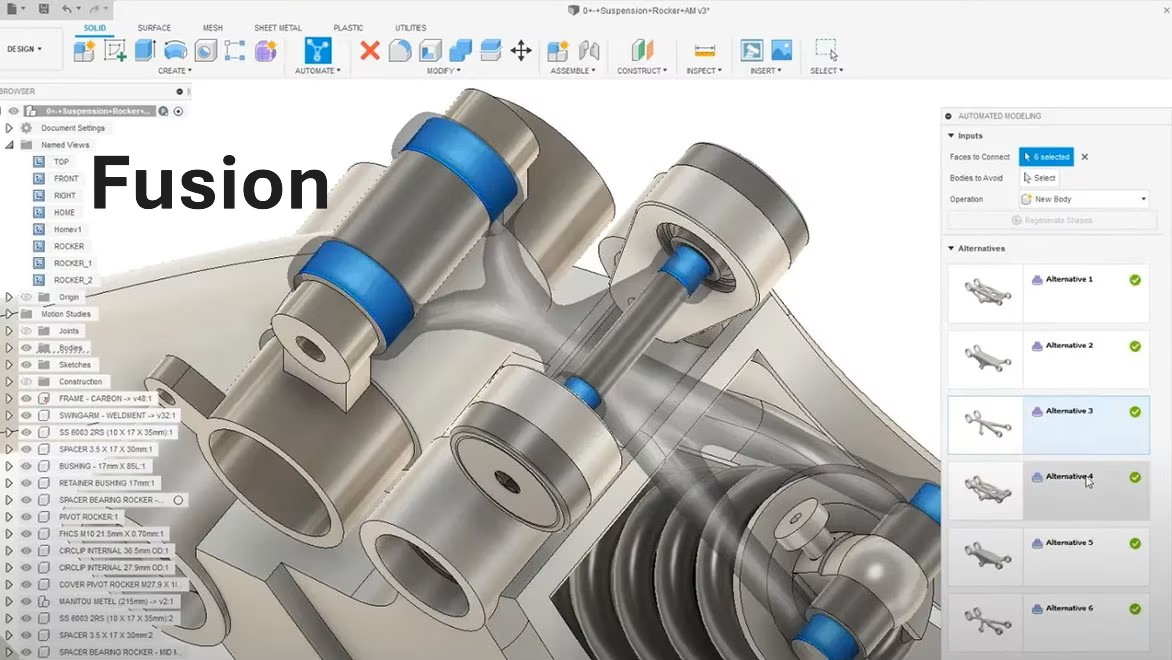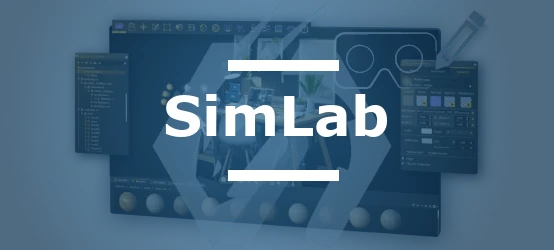
Fusion 360 is a CAD software developed by Autodesk that enables 3D design and modeling in various industries such as mechanical engineering, architecture, and engineering. This solution offers advanced features for creating precise 3D models, designing complex shapes, and managing assemblies.
File formats and native compatibility
Fusion 360 primarily uses the F3D format, which preserves all design information including:
- Parts and assemblies
- Sketches and workplanes
- Materials and properties
Other compatible extensions include .f3z, .f2d, .dwg, and .dxf. F3D files integrate seamlessly with other Autodesk solutions (AutoCAD, Inventor) and enable data exchange with SolidWorks, Catia, and Creo.
Technical architecture and geometric engine
Fusion 360 relies on the Autodesk ShapeManager geometric kernel, derived from the ACIS engine. This architecture offers several technical advantages:
- Simultaneous direct and parametric modeling
- Efficient management of complex assemblies
- Flexible and non-linear design history
- Optimal handling of complex surfaces and solid bodies
The cloud-native architecture facilitates centralized storage while enabling export to various standard formats for interoperability.
Interoperability capabilities and data exchange
Supported import formats
Fusion 360 offers wide compatibility for importing files from different CAD platforms:
- Native formats: Autodesk (Alias, Inventor), SolidWorks, Catia V5, NX, Creo, Rhino
- Standard formats: STEP (AP203, AP214, AP242), IGES, Parasolid (XT, XB), SAT/SMT (ACIS)
- 2D formats: DWG, DXF, PDF
- Mesh formats: STL, OBJ, FBX
Supported export formats
To share your designs with other systems, Fusion 360 offers export to:
- Native formats: F3D, F3Z
- Exchange formats: STEP AP242 (including PMI), IGES, SAT
- Manufacturing formats: STL, 3MF, VRML, OBJ
- Documentation: PDF, DWG, DXF
Note that native formats are not backward compatible with older versions of Fusion.
ACIS interoperability and geometric processing
Since ACIS is the common geometric engine for Autodesk software, saving and reading in ACIS format is done without conversion, eliminating geometric interoperability issues.
Extensions and add-on modules optimizing data exchange
Fusion 360 offers several extensions that enhance its interoperability capabilities:
Manufacturing Extension
- Generation of toolpaths for CNC machines
- Export of G-code compatible with different controllers
- Machining simulation and validation
Simulation Extension
- Finite element analysis
- Exchange of results via neutral formats
- Pre-manufacturing validation
Data Management Extension
- Revision and version management
- Access control and collaboration
- Integration with PDM/PLM systems
Rendering and Visualization Extension
- Creation of photorealistic renderings
- Export to virtual reality platforms
- Preparation for 3D printing
Advanced API exploitation for conversion automation
The Fusion 360 API allows programmatic interaction with models, facilitating the automation of exchange and conversion tasks. This functionality is particularly useful for:
- Accessing and modifying model parameters
- Preserving parametric design intent during exchanges
- Creating custom Python scripts for complex conversions
Matrix transformation features enable precise manipulation of assembly components, essential when preparing models before conversion or reconstructing them after import.
Workflow optimization for data conversion
Adequate preparation of models before conversion is crucial to ensure successful exchanges. This preparation involves:
- Evaluating model complexity
- Identifying potentially problematic features
- Selective simplification when necessary
- Analyzing relationships between components and assembly hierarchy
For large assemblies, a structured approach ensures data consistency after transfer.
SimLab: Complete solution for visualization and utilization of Fusion 360 models
SimLab Composer offers a powerful and flexible solution to fully leverage models created in Fusion 360, thanks to a free integration plugin that establishes a dynamic link between the two applications.
Fusion 360 integration plugin
The SimLab plugin for Fusion 360 functions as an intermediate layer between Fusion 360 and SimLab Composer, allowing users to:
- Create an active link automatically synchronizing data between the two platforms
- Modify the model in Fusion 360 and see the changes instantly applied in SimLab Composer
- Retain materials and modifications applied in SimLab during Fusion model updates (using the "retain scene materials" option)
- Support Fusion 2023 and earlier versions, on both Windows and macOS
Main use cases for SimLab with Fusion 360
SimLab significantly extends the visualization and communication capabilities of Fusion 360 models:
- Creation of immersive VR experiences
- Rapid transformation of Fusion models into interactive virtual reality experiences
- Development of VR training without programming using the Training Builder module
- Creation of interactive animations for virtual reality presentations
- Advanced photorealistic rendering
- Generation of high-quality images, videos, and animations
- Creation of 360° images for immersive presentations
- Application of realistic materials and textures via real-time rendering
- Enhanced technical documentation
- Production of 3DPDF files integrating interactive 3D models
- TextureBaking to improve the realism of shared visualizations
- Capture of scene states with different configurations (transformations, visibility, cameras, materials)
- Training and education
- Creation of quizzes and assessments in VR without coding
- Development of interactive educational material
- VR collaboration for up to 30 participants per session
Advantages of SimLab integration for Fusion 360 users
Using SimLab as a complement to Fusion 360 offers several strategic advantages:
- Optimized workflow: Elimination of repetitive imports/exports thanks to the dynamic link between applications
- Significant time savings: Considerable acceleration of the design-rendering process
- Ease of use: Intuitive interface and rapid learning
- Wide compatibility: Support for 18 input formats and 15 output formats for maximum interoperability
- Parallel processing: Ability to work simultaneously on design in Fusion and visualization in SimLab
SimLab Composer integrates perfectly with Fusion 360 to offer a complete pipeline from design to visualization, significantly improving design communication and making it easy to create immersive experiences from CAD models.
Collaboration and collaborative work
Fusion 360 facilitates collaboration via cloud services such as Google Drive, Dropbox, and OneDrive. Teams can:
- Collaborate in real-time on projects
- Share files with team members
- Access designs from any connected device
The evolution of Fusion 360 since its launch in 2013 demonstrates Autodesk's commitment to continuously improving interoperability capabilities, particularly with the progressive integration of the STEP AP242 exchange format.
Data interoperability with Fusion 360 benefits from advances in exchange standards, facilitating communication between different stages of the product development cycle and ensuring data integrity throughout the design and manufacturing process.


